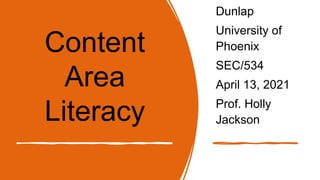Content area literacy
- 1. Content Area Literacy Dunlap University of Phoenix SEC/534 April 13, 2021 Prof. Holly Jackson
- 2. Characteristics of Effective Literacy Teachers • Principal of Praxis • Principle of Purpose • Principle of Serendipity • Principle of Exploration
- 3. Characteristics Cont. • Principle of Reflection • Principle of Community • Principle of Service • Principle of Flexibility
- 4. Sociocultural Influences • According to (Bob Wise, 2009). president of the Alliance for Excellent Education and a former g overnor of West Virginia, adolescent literacy is the cornerstone of students’ academic success. The literacy learning that takes place in adolescents is of critical importance in preparing them for life in and out of school.
- 5. Sociocultural Influences Cont. Elements for improving middle and high school literacy a chievement can come in the form of: • Direct, explicit comprehension instruction • Motivation and self-directed learning • Text-based collaborative learning
- 6. Interdisciplinary Nature • Interdisciplinary Nature is the combining of two or more academic subject areas in one activities Examples: • Science students can go on a nature walk and write about what they evaluated. Using outdoor field study is a way of combining multiple academic subjects. • Science and Social Studies can be combined to give the students a better insight of the weather and what regions have different weather variants and how it can shape an area.
- 7. Local & Global Reach Students can engage in many classroom activities that incorporate local and global issues in various content areas. Encourage students to learn about ecotourism. How and why are countries turning to ecotourism? What are some of the most effective business models that hotels and tourist attractions use? What could be done to make ecotourism even less harmful to the environment? Which places in the world are ripe for ecotourism but haven’t shifted in that direction? Why not? Connect your students with companies or tourism bureaus across the world. Let students collect background information from these organizations, and then offer the organizations free consulting.
- 8. Global & Local Cont. • Skype in the classroom lets you connect with classrooms around the world for free. There are tons of experts in a variety of fields who are willing to spend time talking to students. One of Skype in the Classroom’s most popular features, Mystery Skype, allows classes to play a guessing game with each other to try and figure out where each of the schools are located. You'll be surprised by how many other teachers are interested in collaborating and by how many specialists are so generous with their time and knowledge (McVeagh, 2015).
- 9. Global & Local Cont. • With the Google Field Trip app, students can use the map feature or search by area of interest to find great places to explore. Let’s say your students are reading a novel and you want them to learn about its setting in present day. Have students use the map feature to zoom in on the location, and information "cards" will appear describing a variety of interesting sites, ranging from museums and monuments to theme parks and "haunted" hotels. Structure this activity by setting parameters for your students: Give them a geographical area
- 10. REFERENCES • McVeagh, R. (2015). Common Sense Education. https://www.commonsense.org/education/articles/3- creative-ways-to-teach-global-awareness • Vacca, R. T., Vacca, J. A. L., & Mraz, M. E. (2016). Content area reading: Literacy and learning across the curriculum, enhanced pearson etext with loose-leaf version -- access card package, 12/e (12th ed.). Pearson Education.
Editor's Notes
- Praxis: Effective teachers act on the understanding that education has the power to transform the individual and society. Purpose: Effective teachers operate in the moment guided by a clear understanding of why they are doing what they are doing. There is always a purpose behind their actions in the classroom. Serendipity: Although effective teachers engage in a variety of instructional practices, they “expect the unexpected” and are open to learning opportunities that may occur within the context of instruction. Exploration: Effective teachers are continually exploring new practices and making changes in their practices based on their exploration of instructional possibilities in the classroom (Vacca, R. T., Vacca, J. A. L., & Mraz, M. E. (2016).
- Reflection: Effective teachers think about the what, how, and why of instruction during and after each teaching activity. They engage in the process of reflection to solve instructional problems and set goals. Community: Effective teachers share their classroom knowledge and experiences within and across multiple professional communities as a means of growing professionally and giving back. Service: Effective teachers serve the learners in their classrooms and their parents. Flexibility: Effective teachers plan instruction but are flexible in the implementation of lessons. They adapt to unanticipated events or responses in ways that make learning possible.
- Direct, explicit comprehension instruction, which is instruction in the strategies and processes that proficient readers use to understand what they read, including summarizing, keeping track of one’s own understanding, and a host of other practices Motivation and self-directed learning, which includes building motivation to read and learn and providing students with the instruction and supports needed for independent learning tasks they will face after graduation Text-based collaborative learning, which involves students interacting with one another around a variety of texts
